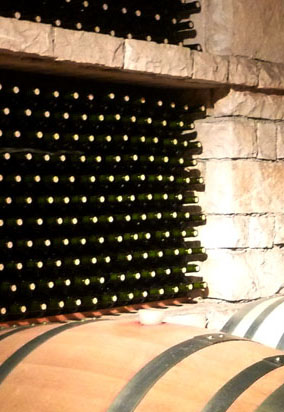At the Tasmanian Red Wine Weekend held in Hobart in May 2015, it stood out how few wines are now bottled under cork. Just ourselves and Domaine A were under cork. It raised a number of issues about red wine in general. Australia has moved strongly towards the closure of wine under screw cap and this can be easily understood when one has tasted a ‘corked’ or oxidised red wine.
So why have we stayed with cork for our red wine closure?
The answer is that we use DIAM cork closure which has been produced by grinding the natural cork to a uniform texture, stripping it of all flavour (including ‘cork taint’ compounds) and compressing it back to a consistent density. We want to exclude the possibility of ‘cork taint’ and oxidation, but at the same time we want the more traditional development that occurs under cork closure.
The screw cap is a ‘perfect closure’ for wine, but development is under totally reductive conditions and extremely slow. The challenge for the winemaker is then : How to ‘prepare’ the wine, knowing that what goes into the bottle at the moment of closure is probably exactly what the consumer will see when the screw cap seal is ‘cracked’ at opening.
This has fundamentally changed the wine making process, requiring more interventions and significant variations to the traditional processes of wine making (and viticulture, as the nature of the grapes determine the wine making process).
So what changes are needed if you opt for screw cap closure on a red wine? Viticulturally one would be tempted to irrigate a little bit more and leave just a few more buds at pruning to increase yield so as to produce softer skinned grapes with lower phenolics and tannins. In the winery it is necessary to reduce extraction of these same compounds by reducing the maceration time on skins and then follow up with gentle pressing. Heavier fining may still be required to achieve ‘balance’ in the wine before finally closing the wine in bottle. The resultant wines are more immediately approachable, fresh, succulent, fruity ‘bliss bombs’ usually summarised by a few descriptors involving ‘fresh fruits’, ‘crisp acid’ and ‘a clean finish’.
But that is not what got me interested in wine in the first place! Living in England for 3 years in the early 1980s, I was strongly influenced by the local wine writers of the time, in particular Hugh Johnson, who had completed his book and TV series “The History of Wine”, an epic piece of research. What struck me was the power of the experience of tasting great wine (as different to good wine, which we are drowning in). This has held it’s spell over us for centuries and results in the most poetic responses when wine writers try to convey this experience.
But what sort of wines are we talking about? Not the fresh, zesty, gulpable and forgettable experiences of most modern wine, but powerful, complex, evocative wines that are nuanced, haunting and mesmerising. These are the wines that demand attention and consideration, what the Italians call “vini di meditazione”. They also seem to demand conversation to explore those flavours and perfumes that seem to be elusive, on the edge of perception. Yes, there are fruit characteristics but it’s the savoury complexity that creates the most intrigue, spices, dried mushroom, undergrowth, tea leaf…the list goes on! Often layered and changing as the wine ‘breathes’ in the glass. These wines, as in the best Bordeaux, Burgundy, Barolo and Brunello, share one thing in common to reach this height of perfection…age!
There is no easy way to get there, despite ongoing attempts by modern wine researchers and the technologies at hand. These wines begin as ‘vin de garde’ as the French call them. Wines ‘made to last’ and age gracefully, but the starting point is not necessarily a pleasure to drink. Often the intensity of the fruit and the higher acid and tannins results in a wine that tastes ‘searing, harsh and drying’. The high tannins can ‘lock up’ the aromatics so the wine has little aroma to allure the first sip. In time, often with some ‘peaks and troughs’ a new wine emerges… when the tannins polymerise, the palate softens and the wine develops its perfume.
Sadly, it feels like there is a ‘collective amnesia’ of the benefits of ageing red wine and the glories made possible especially in a ‘want it now’ society.
To quote the doyen:
“There are some clarets in the world that are simply beautiful; there is no other word for them. They offer as much to the aesthetic sense as great music or great painting. If you ever come to the point of asking what all the fuss is about, why people talk so much about wine, that is the answer. Between the ordinary, which you do not bother to taste consciously before you swallow it, or the superb, which offers and suggests so many beautiful tastes that even after you have swallowed it the perfume lingers on your tongue and your lips, and you cannot bear to let it go…between these two comes the whole study of wine.”
“Wine” by Hugh Johnson, Pub 1966.


